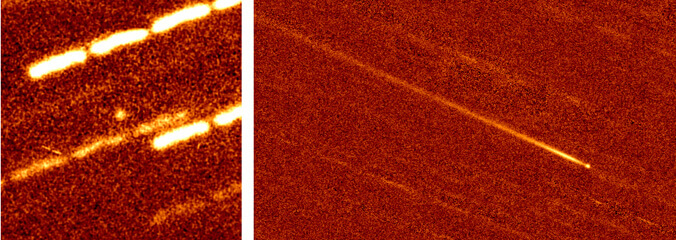
Astronomers using world-leading telescopes, including several observatories on Maunakea and in space, have captured images of a periodic rocky near-Sun comet breaking apart. It marked the first time, 323P/SOHO, a known comet, was detected by a ground-based telescope and was caught in the act of disintegrating, which could help explain the scarcity of the near-Sun population of periodic comets and asteroids.
To better understand these bodies, a group of international researchers including Man-To Hui, a former University of Hawaiʻi Institute for Astronomy (IfA) researcher, and IfA Astronomer David Tholen, observed 323P/SOHO with multiple telescopes on Maunakea including the Subaru Telescope, Canada-France-Hawaii-Telescope (CFHT) and Gemini North, and Lowell Discovery Telescope in Arizona and Hubble Space Telescope.
- Related UH News story: Rare meteor outburst captured by Maunakea telescope, August 3, 2021
Researchers found that 323P/SOHO had changed remarkably during its close passage by the Sun. They believe that the intense radiation from the Sun caused parts of the comet to break off due to thermal fracturing, similar to how ice cubes crack when you pour a hot drink over them. This mass loss mechanism could help explain what happens to the near-Sun population and why there are so few of them left. Astronomers also determined the comet's rapid rotation clocked in at just more than half an hour per revolution, and that its color is unlike anything else in the Solar System.
"Observations of other near-Sun objects are needed to see if they also share these traits," said Hui, who is now an assistant professor at Macau University of Science and Technology. "We couldn't have made this discovery without observations from the telescopes on Maunakea, made possible by the University of Hawaiʻi. The observations from the Subaru Telescope were the initiator, shrinking orbit uncertainties and making follow-up observations possible. CFHT provided the best coverage data and Gemini provided the densest data points."
Since these objects pass so close to the molten heart of the Solar System, they are difficult to spot and study. Most have been discovered by accident in solar telescope observations. According to Hui, the group didn't know exactly where to look because the orbit was poorly constrained. However the wide field of view from the Subaru allowed them to "cast a wide net" and find the comet as it approached the Sun. Using new data, researchers were able to reposition other telescopes when the comet started to move away from the Sun.
"We work very closely with our University of Hawaiʻi users, including David Tholen and Man-to Hui, to optimize their observations, quickly following up observations made at other facilities and using MEGACam to recover interesting objects like 323P/SOHO." said Todd Burdullis, Queued Service Observing operations specialist at CFHT. "Working with UH astronomers studying the building blocks of our solar system never ceases to provide incredible discoveries."
The study was published in the Astronomical Journal.






